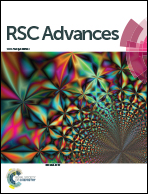Tuning the conductivity type in a room temperature magnetic oxide: Ni-doped Ga0.6Fe1.4O3 thin films†
Abstract
Ni-Doped thin films of the room temperature ferrimagnetic oxide Ga0.6Fe1.4O3 were deposited by pulsed laser deposition and their electronic transport and structural and magnetic properties were studied. The actual insertion of the Ni cations within the Ga0.6Fe1.4O3 structure has been checked by resonant X-ray scattering. A clear extremum is noticed for all properties for the 2% Ni doping: extrema in the crystallographic cell parameters of the films, maximum in the Curie temperature, and maximum in the electric resistivity. We also observed a change of conductivity type for this dopant concentration, from n-type for Ni contents below 2% to p-type for Ni contents above 2%. We explain this behavior by the existence of oxygen vacancies in the pulsed laser deposited Ga0.6Fe1.4O3 thin films, which results in the reduction of some of the Fe3+ into Fe2+ cations, and n-type conduction via a hopping mechanism. The insertion of Ni2+ cations first deals with the presence of oxygen vacancies and reduces the number of n-type carriers in the films, in a compensation-like mechanism. When the number of introduced Ni2+ cations dominates the number of oxygen vacancies, conductivity becomes p-type and starts to increase again. We believe that the tunability of the conduction type and magnitude in thin films of a room temperature ferrimagnetic material paves the way towards new all oxide electronic devices.


 Please wait while we load your content...
Please wait while we load your content...